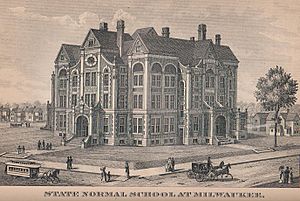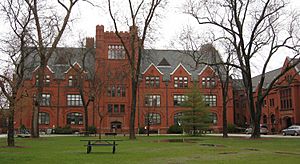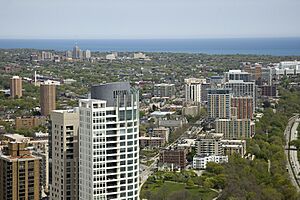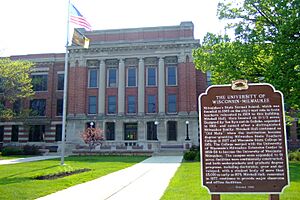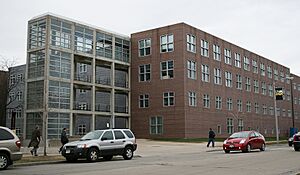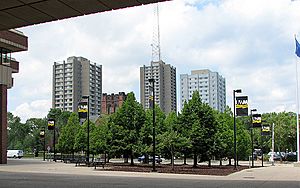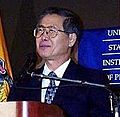University of Wisconsin–Milwaukee facts for kids
 |
|
|
Former names
|
|
|---|---|
| Type | Public research university |
| Established | 1956 |
|
Parent institution
|
University of Wisconsin System |
| Accreditation | HLC |
|
Academic affiliations
|
|
| Endowment | $297 million (2023) |
| Budget | $677 million (2021) |
| Chancellor | Mark Mone |
|
Academic staff
|
6,749 (2021) |
| Students | 24,725 (2021) |
| Undergraduates | 23,004 (2021) |
| Postgraduates | 4,511 (2021) |
| Location |
,
,
United States
43°04′30″N 87°52′58″W / 43.0750°N 87.8829°W |
| Campus | Large City, 104 acres (42 ha) |
| Other campuses | |
| Newspaper | UWM Post |
| Colors | Black and gold |
| Nickname | Panthers |
|
Sporting affiliations
|
NCAA Division I – Horizon League |
| Mascot | Pounce Panther |
 |
|
The University of Wisconsin–Milwaukee (often called UW–Milwaukee or UWM) is a large public university in Milwaukee, Wisconsin. It's a big part of the University of Wisconsin System. UWM is the largest university in the Milwaukee area. It is also one of the two universities in Wisconsin that offers doctoral degrees and is the second largest university in the state.
UWM has 14 different schools and colleges. These include the only graduate school in the U.S. focused on freshwater science. It also has Wisconsin's first public health school and the state's only school for architecture. In the 2015–2016 school year, UWM had over 27,000 students and 1,600 teachers. They offered 191 different degree programs. This included 94 bachelor's, 64 master's, and 33 doctorate degrees.
The university is known for its high level of research activity. Its sports teams are called the Panthers. There are 15 Panther athletic teams that compete in NCAA Division I. The Panthers have won the Horizon League's all-sports championship seven times since 2000. They have also won 133 Horizon League titles and made 40 NCAA tournament appearances.
Contents
Discovering UWM's History
How UWM Started
The university's story began in 1885. Back then, it was called the Wisconsin State Normal School. It opened in downtown Milwaukee to train teachers. The first president, John Mapel, was inspired by his travels in Europe. Over the next 42 years, the school grew a lot. It added programs like music and liberal arts.
In 1919, the school moved to its current location near the lake. A new building, now called Mitchell Hall, was finished. In 1927, its name changed to Wisconsin State Teachers College-Milwaukee. This was to show its main focus on teaching. By the 1940s, it was one of the best teacher training colleges. In 1951, it became Wisconsin State College–Milwaukee. People still often called it "Milwaukee State."
Becoming the University of Wisconsin–Milwaukee
Leaders believed Milwaukee needed a great public university. In 1955, Wisconsin lawmakers decided to create a large public university. This new university would offer advanced degrees in Milwaukee. So, in 1956, Wisconsin State College-Milwaukee joined with the Milwaukee branch of the University of Wisconsin–Extension. This created the University of Wisconsin–Milwaukee.
The new university used both the lakefront campus and a downtown building. The first graduation ceremony for UWM was in 1957. In 1958, Frank P. Zeidler, the mayor, received the first honorary doctorate from the university.
In 1964, UWM bought the campus of a nearby women's college, Milwaukee-Downer College. This helped UWM grow its campus even more. UWM also bought other nearby school buildings.
From 1956 to 1971, UWM was part of the original University of Wisconsin System. In 1971, the state combined all state universities into one big system. This created the united University of Wisconsin System we know today. In 1994, UWM was recognized as a major research university.
UWM has grown to include 12 schools and colleges. It now offers many different programs. These include 88 undergraduate and 48 graduate programs, with 22 doctoral degrees. The university focuses on research, teaching, and helping the community. In 2005, UWM had more Wisconsin resident students than UW–Madison.
In 2006, UWM was named one of the "Saviors of Our Cities." This was because of its strong positive impact on Milwaukee's economy and quality of life. It was also voted one of the top ten "Gems of Milwaukee" by the public.
In 2008 and 2009, UWM opened the School of Public Health and the School of Freshwater Sciences. In 2010, UWM bought the Columbia St. Mary's Hospital complex nearby. This helped the campus expand even more.
UWM's Academic Programs
UWM has 15 colleges and schools. It also has 70 academic centers and labs. In total, it offers 191 degree programs. These include 94 bachelor's, 64 master's, and 33 doctorate degrees. The School of Freshwater Sciences is the only graduate school in the U.S. that focuses on freshwater. It's also only the third in the world!
The Joseph J. Zilber School of Public Health is the first fully accredited public health school in Wisconsin. The School of Architecture and Urban Planning, the College of Nursing, and the College of Health Sciences are the largest in Wisconsin.
UWM Libraries
Golda Meir Library is the main library at UWM. It's a huge library with over 5.2 million items. Many of these can be accessed online. The library building was first built in 1967 and expanded later. In 2009, the Daniel M. Soref Learning Commons was added. This area gives students modern spaces to study and work together.
The library is named after Golda Meir. She was the fourth Prime Minister of Israel. She graduated from the Milwaukee State Normal School, which was a school before UWM. The Golda Meir Library also holds the American Geographical Society Library. This library has almost 2 million items, including maps, atlases, and photos.
Honors College
The Honors College is a special program for selected undergraduate students. It offers a more personalized education. Students in the Honors College get a writing tutor, special advisors, and a private study space in the library. They also get chances to do their own research.
Around 500 students were in the Honors College in 2008. About 60 students earned an Honors degree each year.
Research at UWM
UWM is known as a "Very high research activity" university. This means it does a lot of important research. In 2015, the university spent $68 million on research. It was ranked 179th among U.S. research universities for its total research spending in 2010.
UWM Research Foundation
The UWM Research Foundation helps turn the university's research and new ideas into real-world products. It helps manage new inventions and connects researchers with companies.
Research Growth Initiative
The Research Growth Initiative (RGI) is a program that helps UWM's research grow. It invests in projects that are expected to bring in more funding from outside sources. Getting into this program is very competitive. Proposals are reviewed by experts from around the country.
Exploring the UWM Campus
The UWM campus is about 104 acres big. It's located in a neighborhood on Milwaukee’s upper East Side. The campus is only five blocks from Lake Michigan. It's also less than a ten-minute drive from downtown Milwaukee. Public buses make it easy to get to campus. The campus is split into central, north, west, and northwest areas. UWM also has other locations around the Milwaukee area.
Central Campus Area
At the north end of the Central Campus is the UWM Golda Meir Library. This is a very important library. It has three parts: the West Wing, East Wing, and a conference center. The library was named after Golda Meir in 1979.
At the south end of the Central Campus is the UWM Student Union. This is the main hub for student life. It's one of the largest student centers in the country. Over 26,000 people visit it every day during the school year. The Golda Meir Library and the Student Union are connected by the Ernest Spaights Plaza. This is a central gathering spot for UWM.
Next to the plaza is Bolton Hall. This building houses departments like Sociology and Political Science. It also has student support centers. West of Bolton Hall is Lubar Hall, home to the Sheldon B. Lubar School of Business. This building has classrooms, computer labs, and offices. It can hold 2,000 students at once. It was named after Sheldon B. Lubar, a well-known Milwaukee businessman.
On the east side of the Ernest Spaights Plaza are the Art, Music, and Theatre buildings. These are part of the Peck School of the Arts. Other important buildings in this area include Mitchell Hall, which was the original building for the Milwaukee State Teachers College.
North Campus Area
The north side of the North Campus has Downer Woods. This is a wooded area and nature center. On the west side are the Sandburg Residence Halls. This is a large complex of four tall dorm buildings. Sandburg Residence Hall can house about 2,700 students.
In the middle of the North Campus are the school's indoor sports facilities. These include the Klotsche Center and the Pavilion. Next to these are Chapman Hall and Enderis Hall. Enderis Hall is 11 stories tall and houses the College of Health Sciences and the School of Education.
The east side of the North Campus has a group of older red buildings. These include Holton Hall, Merrill Hall, and Johnston Hall. These buildings were bought when UWM expanded by purchasing the Milwaukee-Downer College campus.
West Campus Area
The West Campus is where you'll find the College of Engineering and Applied Science. It also has the College of Nursing, the School of Architecture and Urban Planning, and the natural science departments. The College of Engineering is in the EMS building. The Physics, Chemistry, and Lapham Hall buildings are also here. Cunningham Hall houses the College of Nursing.
The Architecture and Urban Planning Building was completed in 1993. It's one of the largest architecture school buildings built in the U.S. in recent decades. It has classrooms, design studios, and computer labs. Its design even shows off the building's structure inside.
In 2015, UWM opened the Kenwood Interdisciplinary Research Complex. This is a modern, large building for research. In 2019, the UWM Lubar Entrepreneurship Center and UWM Welcome Center opened.
Surrounded by buildings in the West Campus is Engelmann Stadium. This is where the Milwaukee Panthers men's and women's soccer teams play. Built in 1973, it's a unique stadium because it's tucked between other buildings. It hosts the Panther Invitational, a long-running soccer tournament.
Northwest Campus Area
The former Columbia-St.Mary's hospital was bought by UWM in 2010. This complex has seven buildings and a parking garage. It added 20 percent more space to the campus. Currently, it houses the School of Information Studies and UWM's child care center. Some older parts of the complex are being taken down.
UWM Athletics: Go Panthers!
UWM has had three different mascots and nicknames. First, they were the Green Gulls (1910–1956). Then, they were the Cardinals (1956–1964). Since 1964, they have been the Panthers!
There are 15 Panthers athletic teams. They compete in the Horizon League at the NCAA Division I level. UWM joined this league in 1994.
Men's Basketball
The men's basketball team has had some exciting moments. In 2003, they won their first Horizon League Tournament. This led to their first appearance in the NCAA Men's Division I Basketball Championship. They returned to the tournament in 2005 and gained national attention. They beat Boston College to reach the Sweet Sixteen! In 2006, they pulled off another upset against Oklahoma.
Football History
Milwaukee stopped its official football program after the 1974 season. Even though it was a smaller program, six players went on to play in the National Football League. One famous player was Mike Reinfeldt, an All-Pro safety for the Houston Oilers.
Since 2003, Milwaukee has had a successful club football program. This is a student-run team. They used to play against Marquette University in a game called the Brew City Classic. The Panthers kept the Golden Keg trophy for many years. In 2012, they were ranked 7th nationally among club football teams.
Other Sports
UWM's men's baseball and women's volleyball teams have also done very well. The baseball team has had six seasons with 30 or more wins in the last nine years. They've been to three NCAA Tournaments since 1999. This includes a big win over top-ranked Rice University in 1999. The volleyball team has also been to six of the last nine NCAA Tournaments.
The club bowling team has been successful too. They won the Wisconsin Collegiate Bowling Conference in 2011 and 2013. In 2011, they were ranked 27th in the nation. The men's club lacrosse team, started in 2010, won the Great Lakes Lacrosse League Championship in 2011 and 2015.
Student Life at UWM
Student Housing
UWM offers several places for students to live. These include Cambridge Commons, Kenilworth Square Apartments, RiverView Residence Hall, and Sandburg Halls.
Sandburg Halls is the biggest student residence hall on campus. It has four towers and can house 2,700 students. The rooms are set up in suites with three or four rooms. The East tower, opened in 2000, has full kitchens. Sandburg Hall was updated in 2008 with an eco-friendly roof. Inside, you'll find a cafeteria, fitness center, convenience store, coffee shop, and a movie theater for residents. There are also outdoor areas for sports like tennis and volleyball.
Kenilworth Square is about a mile south of the main campus. It houses about 330 older students in apartments. It's in a converted Ford factory that also has classrooms and art studios.
RiverView Residence Hall opened in 2008 for first-year students. It's a few blocks west of Kenilworth Square and can hold 470 students. There are shuttle services to the main campus. Some classes are even held in the residence hall.
Cambridge Commons is the newest residence hall. It opened in 2010 and houses 700 students. Some apartments have living rooms and kitchens. The lobby has a fireplace, music practice rooms, and a computer lab. Cambridge is a "LEED Gold certified building." This means it's very environmentally friendly, with green roofs and solar panels.
Students can also find apartments and rental houses in the neighborhoods around campus.
UWM Media
The UWM Post is an online newspaper run by students. The Journalism, Advertising and Media Studies department also publishes student work on Media Milwaukee, an online news site.
The College of Letters and Science runs WUWM. This is a public radio station in Milwaukee. It provides news, public affairs, and entertainment to southeastern Wisconsin. PantherU.com is a website that covers Milwaukee Panthers sports news.
Student Organizations
There are over 300 student organizations at UWM! The main student government is the Student Association of UWM. This group works with the university to make sure students' rights and interests are heard. Other student groups cover many different interests. These include political clubs, academic clubs, cultural groups, and sports clubs.
Greek Life
UWM has many Greek organizations, like fraternities and sororities. These include groups from the IFC Council, Panhellenic Council, Multicultural Greek Council, and NPHC.
| Interfraternity Council Fraternities | Panhellenic Council Sororities | Multicultural Greek Council Fraternities and Sororities | National Pan-Hellenic Council Fraternities and Sororities |
|---|---|---|---|
|
|
|
|
Pantherfest
Pantherfest is a big event held at the start or end of each school year. It takes place at the American Family Insurance Amphitheater near Milwaukee's lakefront. It's the biggest event of the university's Fall Welcome activities. It celebrates the start of the school year with many campus events. Pantherfest started in 2007 and is paid for by student fees. Famous performers like Lupe Fiasco, Kid Cudi, Twenty One Pilots, and Kesha have played there. Pantherfest also includes a street festival on campus with free food and activities for students.
Panther Prowl
The Panther Prowl is an annual running race. It's sponsored by the UWM Alumni Association. People run across the UWM campus and Upper Lake Park. The race raises money for student scholarships and alumni programs.
Performing Arts Venues
UWM's Peck School of the Arts has four places for performances. These include music, dance, theater, and film. Music shows are held in the Bader Concert Hall or the Recital Hall. Theater shows are in the Mainstage Theater or Studio Theater. Dance performances are in the Mitchell Hall Dance Studio. The film department also has a new place to show student films.
Campus Safety
UWM has its own University Police Department. It's open 24 hours a day, every day of the year. There are 43 police officers and 22 security officers. UWM also offers a safety escort service called SAFE. There's also a shuttle van service called BOSS (Be On the Safe Side). Plus, an emergency alert system keeps everyone informed.
LGBT+ Services
In 2014, UWM was named one of the "top 50 LGBT+-friendly colleges and universities" in the United States. This was by the Campus Pride organization. UWM was the only college in Wisconsin to make that list! This rating looks at how friendly a campus is to LGBT+ students.
Smoke-Free Campus
In June 2018, UWM became a smoke-free campus. This means smoking is not allowed anywhere on university property. This policy helps keep the campus safe and healthy for everyone.
Notable Alumni and Faculty
-
Satya Nadella, the CEO of Microsoft Corporation
-
Golda Meir, the fourth Prime Minister of Israel
-
Alberto Fujimori, the 62nd President of Peru
-
Larry N. Vanderhoef, former chancellor of University of California, Davis
-
Raquel Rutledge, a Pulitzer Prize-winning journalist
-
Alan Kulwicki, the 1992 NASCAR Cup Series Champion
See also
- Great Lakes WATER Institute
- Einstein@Home
- Milwaukee Cup
- Lapham Memorial
- Jantar-Mantar
- Milwaukee
- Three Bronze Discs


